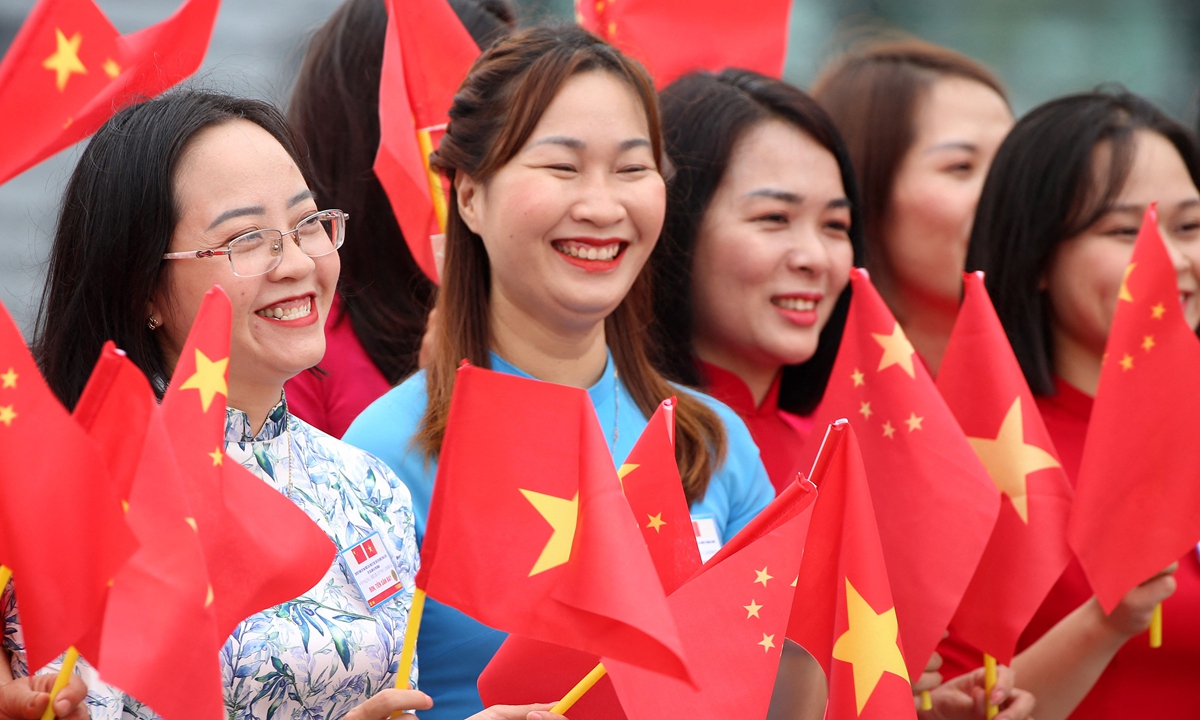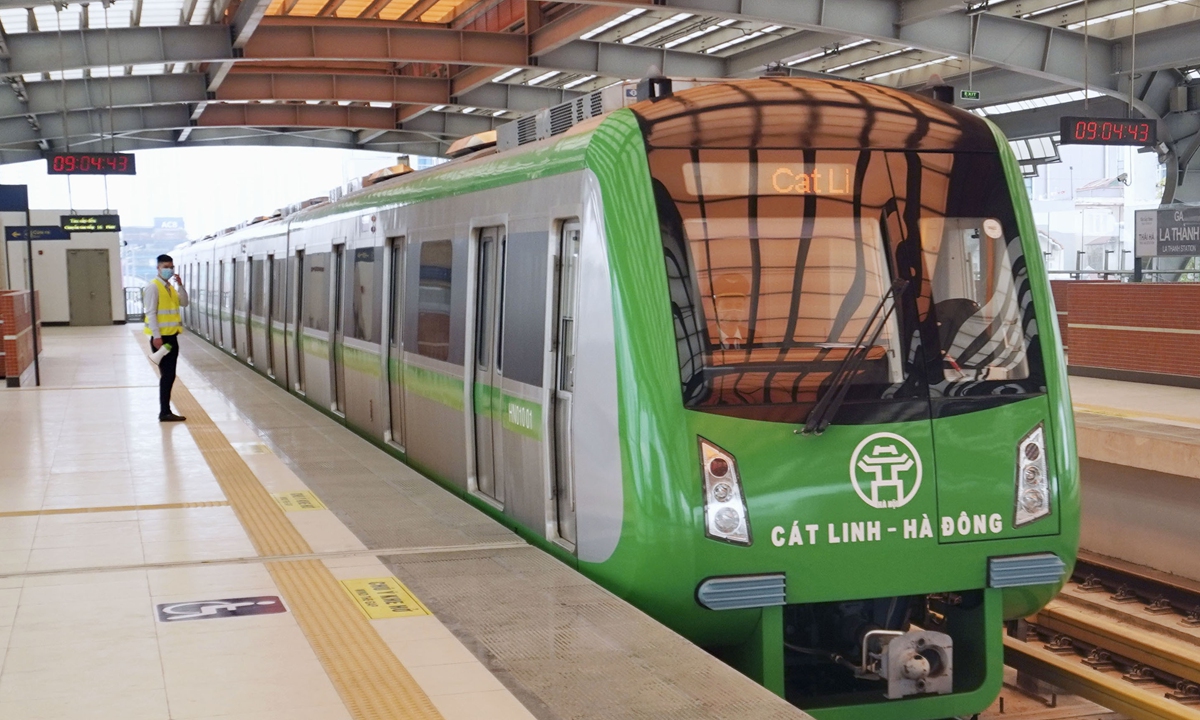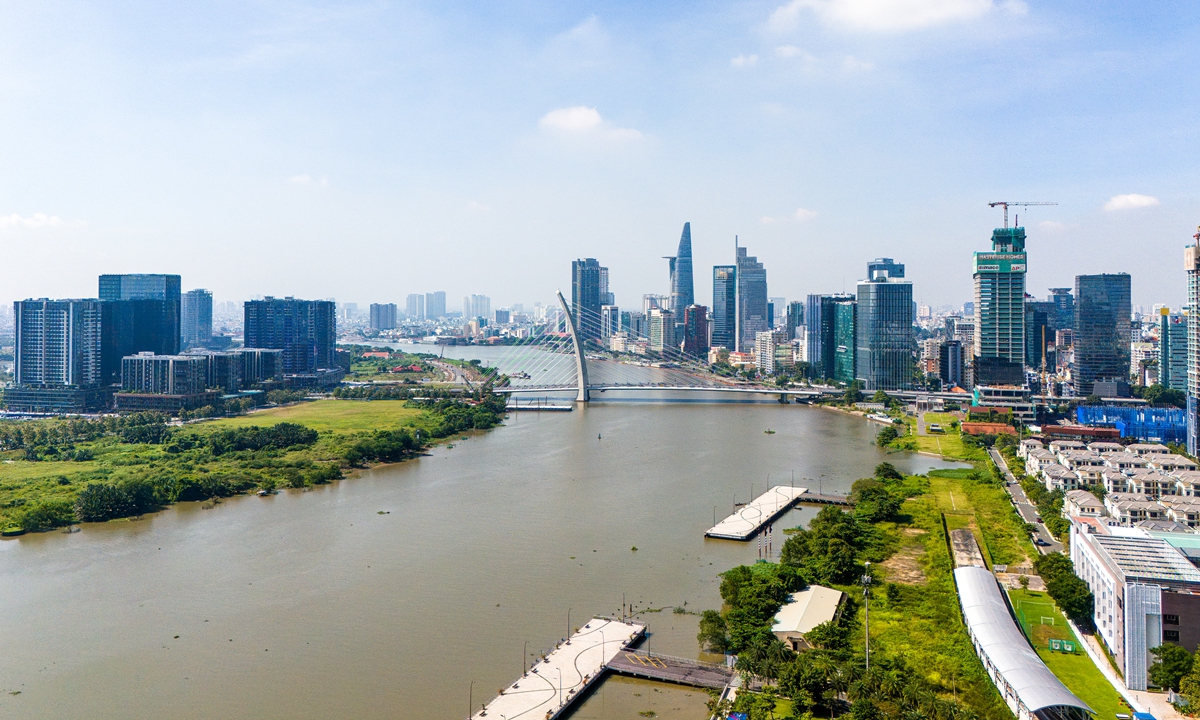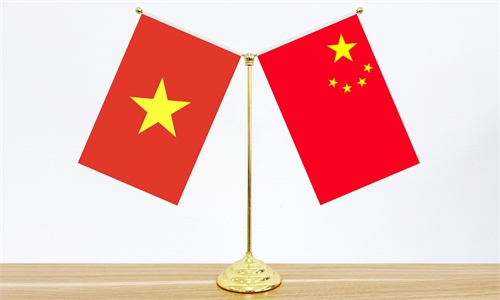IN-DEPTH / IN-DEPTH
Xi's Footsteps: Beijing-Hanoi cooperation an epitome of China-world interaction

Local Vietnamese people gather on the streets in Hanoi to welcome the visit of Xi Jinping, general secretary of the Communist Party of China Central Committee and Chinese president, on December 12, 2023. Photo: VCG
In mid-December, Beijing was covered in heavy snow, while about 2,300 kilometers away, Hanoi remained a tropical summer. A visit brought the two places closer, and displayed a highlight moment in the China-Vietnam relationship.
Xi Jinping, general secretary of the Communist Party of China (CPC) Central Committee and Chinese president, paid a state visit to Vietnam from December 12 to 13, at the invitation of the General Secretary of the Communist Party of Vietnam (CPV) Central Committee Nguyen Phu Trong and State President of the Socialist Republic of Vietnam Vo Van Thuong.
Nearly 40 cooperation documents between China and Vietnam are on display at the premises of the CPV Central Committee. When visiting the premises, Xi said with delight - our cooperation is fruitful and dazzling.
For the people
As Xi emphasized during his phone talk with Nguyen Phu Trong in January 2020, the significance of expanding China-Vietnam cooperation lies in making people from both countries gain a greater sense of achievement and happiness.
From Xi's signed article titled "Building a China-Vietnam Community with a Shared Future That Carries Strategic Significance And Writing Together a New Chapter in Our Modernization Drive," published on December 12 by the Vietnamese Nhan Dan Newspaper, to Xi's speech at a meeting with representatives of young Chinese and Vietnamese people who have contributed to the China-Vietnam friendship the following day, at which one example was mentioned twice - Vietnam's first urban light rail project, the Cat Linh-Ha Dong metro line, built by a Chinese company.
Luong Thi Hai Van, a Vietnamese vice professor at the Guangxi University for Nationalities, told the Global Times that her friends in Hanoi are so happy with the convenience brought by the metro line. "Hanoi is the capital city of Vietnam with a dense population and traffic jams during peak hours. But now the traffic jams have been greatly eased. This is a 'revolution' for the people living in Hanoi," Luong said.
The metro line, constructed by a Chinese company, is a landmark project that connects the China-proposed Belt and Road Initiative (BRI) with Vietnam's "Two Corridors, One Economic Circle" strategy. The line is approximately 13 kilometers long with 12 stations. The entire journey takes only 23 minutes by metro train, which is nearly 1 hour faster than traveling by car and 20 minutes faster than traveling by motorcycle. The line has already served nearly 20 million passenger trips so far, making travel in Hanoi more convenient.

The China-constructed Cat Linh-Ha Dong metro line commences commercial operation in Hanoi on November 6, 2021. Photo: VCG
Du Bin, deputy chief engineer of the Chinese construction enterprise China Railway Sixth Group's overseas branch and project manager of the Cat Linh-Ha Dong metro line, told the Global Times that one of the most impressive memories during the project construction was the scene when the first locomotive arrived at the construction site. The installation of the large locomotive lasted until 3 am in the light rain, yet the streets were still filled with people who came to watch. Some said they were eagerly looking toward to a ride on Vietnam's own light rail metro.
Nowadays, "the metro has become a popular spot in Hanoi's urban development and a favorite place for people to take trendy photos," Du said.
There are many other similar examples. In 1997, the China State Construction Engineering Corporation (CSCEC) undertook the construction task of the Nguyen Van Linh Parkway - a highway that stretches from Ho Chi Minh City further south to the southern part of Vietnam, with a total 12 lanes and length of 17.8 kilometers. Before the highway was built, the construction site was almost entirely marshland and the highway had to cross 10 rivers. The time given to the contractors was fairly short.
For a time, it was considered mission impossible. But now, the highway, which literally spans 10 rivers with its widest part being 120 meters, is operational.
Lu Yen, a Chinese-Vietnamese employee of the CSCEC, told the Global Times that a good transportation infrastructure brings prosperity to a region. Nguyen Van Linh Parkway and the surrounding auxiliary roads have successfully connected seven districts, and the entire road is surrounded by greenery.
Lu said before the construction, the road was only a 6-meter-wide dual carriageway, with small shops and scattered tin houses on both sides, making the already congested road even more difficult to navigate. Now, the Ho Chi Minh City Medical University Hospital, Ton Duc Thang University, as well as business zones, and shopping malls like ViVo City, Parkson, have settled around the parkway, greatly improving the lives of local residents.
Lu passes by Nguyen Van Linh Parkway every day on her way to work. "Looking at the projects that I participated in, looking at the towering buildings and the supporting facilities around them, I feel that not only have the roads been widened, but also has our space for happiness," she said.
Opportunities for future
In 2015 and 2017, Xi visited Vietnam twice as the general secretary of the CPC Central Committee and the Chinese president. Similar to the most recent visit, Xi attended a wreath laying ceremony at the Ho Chi Minh mausoleum, Hanoi, in both previous visits.
"The memory of those fiery and exciting years of our two peoples is kept alive," Xi said on December 13, when recalling the times when the two countries were fighting for national independence and liberation, adding that "today, we remain firmly committed to our shared aspiration forged in the early days and are pursuing win-win cooperation."
During the visit in November 2017, Xi attended the inauguration and handover ceremony of Vietnam-China Friendship Palace and the inauguration ceremony of the Hanoi China Culture Center, then shook hands and extended warm greetings with the present Chinese and Vietnamese guests, encouraging them to make positive contributions toward strengthening friendly exchanges and cooperation between the two countries.
"When Xi visited Vietnam in 2015, he gave a speech to Chinese-funded institutions, overseas Chinese, and students. I attended the event," Miao Renlai, president of the Chinese Business Association Ho Chi Minh City Branch, told Global Times. Miao recalled that Xi's voice was magnetic and pleasant.
"Xi spoke to us like a parent - friendly, approachable, and inspiring… He introduced the development of bilateral cooperation between China and Vietnam, which encouraged us and boosted our confidence in developing our businesses and careers in Vietnam," Miao said.
In 2017, when Xi visited Vietnam for the second time, Miao also made a special trip to Hanoi from Ho Chi Minh City to welcome Xi and hence experienced the warm welcoming atmosphere both at the airport and along the way from the airport to the hotel where Xi stayed.
Miao told the Global Times that Xi's visit not only brought new opportunities to him, but a breakthrough in entire bilateral trade between China and Vietnam. Looking back at the past achievements of the China-Vietnam cooperation, its breadth and depth are remarkable. China has been Vietnam's largest trading partner for consecutive years, and Vietnam is China's largest trading partner in the ASEAN and fourth-largest trading partner globally. From about $100 billion in bilateral trade volume in 2017 to a total two-way trade turnover of $175.57 billion in 2022, the trade volume has almost doubled in recent years.
There are some eye-catching figures: In the first 10 months of this year, the number of China-invested projects in Vietnam ranked first among all foreign investment projects in the country, with the investment amount increasing by 98 percent year-on-year. China is Vietnam's largest fruit and vegetable export market with a turnover of $2.75 billion, up 160 percent over the same period in 2022 and accounting for 65 percent of the country's total fruit and vegetable export turnover.
The most remarkable achievement during Xi's latest visit was the joint announcement of a new positioning for the two parties and two countries, which is to build a China-Vietnam community with a shared future that carries strategic significance.
"Vietnam, China sign 36 agreement documents for cooperation," read a headline by the VnExpress. Experts said, compared with previous high-level visits, the achievements reached during the latest visit are the most extensive in terms of coverage, the largest in terms of quantity, and the deepest in terms of cooperation.
Detailed cooperative plans are listed in the joint statement. Even in terms of the South China Sea, where controversies and disputes exist, there are specific promotions of cooperation.
For instance, the two sides agreed to continue effective joint patrols on the Beibu Gulf and military ships' mutual visits as well as deepen exchange and cooperation mechanisms between the naval and coast guard forces. They also agreed to study the establishment of methods for resolving civil and border trade disputes, and promote legal and judicial cooperation between localities that share the borderline in appropriate forms.
Other future-oriented plans include effectively deploying an economic-trade cooperation zone, focusing on intensifying investment cooperation in such fields as agriculture, infrastructure, energy, the digital economy, and green development, and promoting standard-gauge railway connectivity across the bilateral border while studying and promoting the building of Lao Cai-Hanoi-Hai Phong standard-gauge railway route.
"I have always looked forward to the day when I can take a Chinese high-speed train home. Now, I feel that this hope is not far away," Miao said.

An aerial view of the Saigon River and surrounding buildings in Hanoi, Vietnam. Photo: VCG
Increased happiness index
Ten years ago, Xi proposed the four-point principle of "amity, sincerity, mutual benefit, and inclusiveness" in developing neighborhood diplomacy, and clarifying the direction of how "neighbors who cannot be moved" can coexist. Ten years later, fruitful results have been achieved. China has established a bilateral community with a shared future with a growing number of neighboring countries.
Light was shed upon the principle again on December 13 in Hanoi. During his speech at the meeting with representatives of young Chinese and Vietnamese people, Xi stressed: "What we are pursuing is not modernization just for China itself… We are ready to share more of the benefits of Chinese modernization with our neighbors… And we should pursue our respective paths to socialism and deliver the gains of industrialization and modernization to more people of our two countries."
An example can be found in the Chinese-Vietnamese employee of the CSCEC Lu's story. She said the CSCEC not only provides job opportunities for the locals, but also carries out training programs to help improve local workers' technical skills. "When we have more stable income, improved infrastructure, and a better living environment, our happiness index is increased."
According to Miao, when Chinese enterprises go abroad, they must prioritize localization of the companies - not only recruiting local talent, but cultivating local people to take up management positions. "Our business associations often talk to the Chinese-funded enterprises and remind them to comply with local laws, regulations, religious culture, and customs; to live and work in harmony with Vietnamese citizens for mutual benefit," Miao said, adding that China is not developing on its own, but developing together with everyone. "In this way, people from other countries will respect us more and when every Chinese person is respected aboard, that means China's genuine rise," Miao stressed.
"China and Vietnam are connected by mountains and rivers," goes the song "Vietnam-China," a classic Vietnamese song about the traditional friendship between the two countries. It carries the message - neighbors wish each other well; just as loved ones do to each other.
China-Vietnam relations are a microcosm of China's interaction with the world. "Our two Parties are both Marxist parties that bear in mind the overall interests of the world, and our two countries are both responsible members of the international community. And both of us should play a major role in advancing human progress," Xi expressed his wishes during his speech at the meering with the representatives of young Chinese and Vietnamese people.
It is widely believed that the construction of a China-Vietnam community with a shared future will become a new starting point for the development of bilateral ties. This will not only help people of the two countries to live a better life together, but also bring more positive energy to the Asia-Pacific region and the world.

